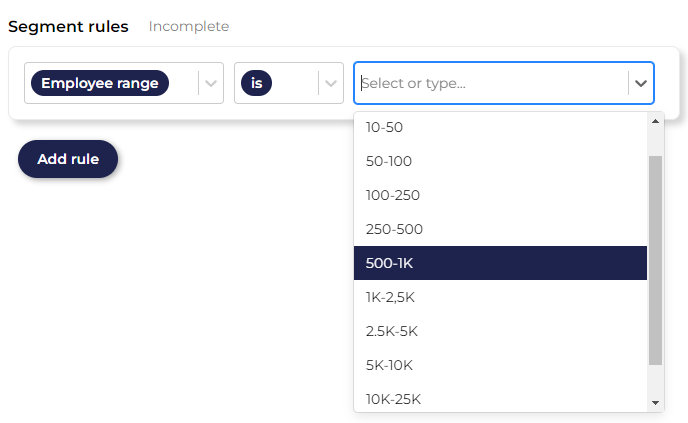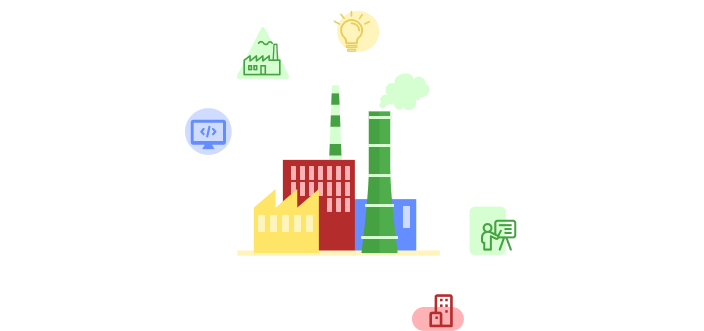Firmographic data is a term thrown around in B2B sales and marketing to describe a set of characteristics related to a company. Read more about how to use firmographic data to segment your customers, find your ideal customer profile, and generate leads.
What are firmographics and why are they important?
Firmographics are characteristics of a company such as its revenue, industry, number of employees, technographics, domain address, and headquarters location. There are many more data points but these are the most common ones to describe a company.
Sales and marketing people use firmographics to understand who they should target when running outbound and inbound campaigns. Firmographics are useful because companies with different characteristics are interested in different things and are trying to solve different problems. They help businesses tailor their marketing and sales strategies to better meet the needs of their target markets. For example, a company with a lot of revenue is likelier to buy enterprise software compared to a company with little revenue.
By understanding and utilizing firmographics, businesses can improve their chances of success in the B2B space and better understand the dynamics of their target market.
What is firmographic segmentation?
Firmographic segmentation is used to group a large customer base into smaller segments to have better-targeted sales and marketing efforts. For example, a group of companies can be segmented into ones that have 50-100, 100-250, and 250-500 employees.

Employee range segmentation
When a marketer offers their product to the right customer segment with a tailored message suitable for that segment, the customer is much likelier to buy. On the other hand, if a marketer approaches the segment with a message that is not compelling to them, the customers leave your emails unopened or leave your website. Different customer segments simply want and need different things so it's hard to maximize revenue with the same generic messaging.
Firmographic segmentation can be used in the first step of account-based marketing (ABM) campaign to identify the best-fit customers. Simply determine how to split your market into smaller groups using firmographics until you find the customers that are the likeliest to receive the most value out of your product.
Industrial segmentation is part of firmographic segmentation. It means segmenting companies based on their industry to create industrial segments such as "Consumer goods" or "Software services".
Firmographics vs demographics
Firmographics and demographics are similar in that they both provide information about a target market or audience. However, firmographics focus on a company's characteristics and demographics, such as size, industry, geographic location, and decision makers, while demographics focus on the characteristics and demographics of individuals, such as age, gender, income, and education.
Firmographics are typically used in the B2B space to better understand a company's potential fit with a product or service and tailor marketing and sales strategies, while demographics are typically used in the B2C space to better understand the characteristics and needs of individual consumers. Understanding both firmographics and demographics can help businesses better understand their target market and improve their chances of success.
Top benefits of firmographic segmentation
Optimized resource allocation
One of the benefits of firmographic segmentation is the smarter use of company resources, eg. by sending better-targeted emails. Companies targeting all customers waste resources by trying to sell to customers who are unlikely to buy their product. Segmentation focuses the sales and marketing effort to only target those customers who are the likeliest to be most interested and who have sufficient resources to buy.
Improved customer communication and relationship
B2B customers today expect personalized communication. 65% of buyers are ready to switch vendors if they don't personalize their communication to the customer. Customer segmentation using firmographics is a step towards better personalization when the messaging is tailored to that specific narrow segment.
Better ROI
While saving resources just purely doing less work, more targeted segmentation helps you increase conversion rates leading to less money wasted. The improved ROI translates throughout lead generation but also customer retention. Better fit customers tend to not churn.
Ways to use firmographic segmentation
Inbound website lead generation
While firmographics are in popular use in outbound marketing and sales, inbound marketing can also benefit from using firmographic segmentation to maximize lead generation when combined with personalization.
Companies can use modern B2B website personalization to identify companies on a website, segment them based on firmographics, and show the visitor a version that is likeliest to resonate with them.

Personalized website using company size and industry to convert more leads
Website copy, images, logos, and call-to-actions should be optimized to best reflect the visitor's own background so that the content is as relevant as possible. More relevant content has been shown to increase conversions by 50-200%.
Find prospects fitting your Ideal Customer Profile
When you're prospecting, use firmographic segmentation to narrow your search. You can also tailor your message to fit the needs of the audience better when you apply good firmographic segmentation.
8 variables for firmographic segmentation and targeting
Domain
A company domain can be used to learn more about a company that is not immediately obvious by looking at its name, revenue, or industry. The website is a gold mine of additional data such as which customers the business serves, whether it's a B2B or a B2C company, and how it positions itself in the market.
Industry
The company industry is very relevant data when its accurate and detailed. Industry can be used to target specific offerings if your product only fits a niche industry. For example, a company selling healthcare devices should only focus on the healthcare industry.
Annual revenue and amount of employees
Revenue and employee numbers are a good estimate of a company's size. The company size approximates well which problems it might be solving and whether they need your product.
For example, imagine you're selling an email marketing product, a company with a few employees might value ease of use of your product while enterprise customers value automation and security.
Technographics
The technologies a company is using tells a lot about the way it conducts its business. For example, a company using Hubspot might be more focused on inbound sales than a company using Salesforce.
Headquarter location
A company's location tells a something about the company's culture and things they might value. Nordic B2B companies with a flat organizational structure buy products very differently than companies in Asia with a high organizational structure. They also prefer to buy in very different languages if they have the freedom of choice.
Status/Type
Company types refer to the legal structure or classification of a company, which can include information such as whether the company is a
- corporation,
- partnership,
- sole proprietorship,
- privately held company,
- Public Limited Company (PLC),
- or Limited Liability Company (LLC).
Company types are important because they can provide valuable insights into the company's ownership structure, decision making processes, and potential fit with a product or service. For example, if you want to form an LLC in your state you need to know which LLC type suites you best, as there are eight different types of it, each with advantages and disadvantages that you should become familiar with before you start your business. By understanding a company's type, businesses can tailor their marketing and sales strategies. For instance, a startup may choose to become an LLC due to its simplicity and flexibility. By forming a Limited Liability Company (LLC), owners can separate their personal assets from their business liabilities, providing an added level of security.
Performance
Company performance refers to the financial health and success of a company, which can include metrics such as revenue growth, profit, market share, and customer satisfaction.
Company performance is important because it can provide valuable insights into the company's potential fit with a product or service, as well as its ability to engage in business transactions.
For example, a company with strong financial performance is likely to be in good standing and able to invest in new products or services, while a company with poor financial performance may not have the same resources or capacity.
What is an industry segment in B2B?
An industry segment in B2B is a group of companies or businesses within a specific industry that share similar characteristics or target markets and engage in business-to-business transactions.
For example, the B2B technology industry may be divided into segments based on the type of technology (such as cloud computing, cybersecurity, or artificial intelligence), the size of the target market (such as small or medium-sized businesses), or the geographic location of the companies (such as domestic or international).
Understanding and analyzing industry segments in B2B can help businesses tailor their strategies and products to better meet the needs of their target markets and improve their chances of success in the B2B space.
B2B customer segmentation examples
Some examples of B2B customer segmentation include:
-
Industry: Segmenting customers based on the industry they operate in, such as manufacturing, healthcare, or finance.
-
Company size: Segmenting customers based on the size of their company, such as small, medium, or large.
-
Geography: Segmenting customers based on the geographic location of their company, such as domestic or international.
-
Company type: Segmenting customers based on the type of company, such as public or private, profit or non-profit.
-
Decision maker: Segmenting customers based on the person or group responsible for making purchasing decisions, such as a CEO, CFO, or procurement team.
-
Purchase history: Segmenting customers based on their past purchasing behavior, such as the products or services they have purchased, the frequency of their purchases, or the value of their purchases.
By segmenting customers, businesses can tailor their marketing and sales strategies to better meet the needs of their target markets, improving the chances of success in the B2B space.
Related personalization playbooks
How to personalize content by industry
How to personalize your website by company size
How to guide customers to the right sales channel




